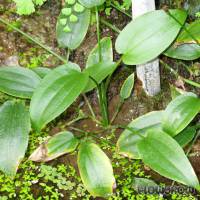



Echinodorus horizontalis is a medium-sized sword plant originating from the Amazon depression in the north of South America. In contrast to many other Echinodorus species that grow in more or less sunny locations, E. horizontalis is most often found on shaded ground of marsh woods or temporarily flooded forests or the banks of rainforest rivulets. There it is subject to rapid changes of the water level. When flooded, it develops submersed leaves that have the same form as its emersed ones.1 E. horizontalis is e.g. found in Yasuní national park (Ecuador), together with the closely related Echinodorus tunicatus.
In earlier decades, E. horizontalis was widely distributed in the aquarium hobby and was exported from the area near Iquitos (Peru) together with e.g. Echinodorus grisebachii (type E. parviflorus?) (Lehtonen & Arévalo 20052). Today it is only rarely cultivated and it is hard to come by in trade (sometimes, other species or hybrids are erroneously carried under the name E. horizontalis). E. horizontalis is a rather demanding plant when cultivated emersed in an aquatic plant nursery, it is susceptible to fungal diseases3 and has a lesser reproduction rate than many other sword plants. However, when cultivated submersed in the aquarium this plant grows quite well and even forms flower stalks with adventitious plants. Thus the survival of this beautiful plant in aquaristics depends almost entirely on hobbyists.
As the species name suggests, the leaf blades of E. horizontalis grow more or less horizontally, be it emersed or submersed. They are longish-oval with a heart-shaped base and an acute tip. The lateral veins meet the longitudinal veins in an almost accurate right angle. The transparent patterns (pellucid leaf areas) within the leaves form a gridlike pattern in this species. The leaf stalk is smooth, its cross section is round. The leaves are of a light to medium green colour, new leaves are often of a light reddish-brown. They are relatively firm and rigid.
The emersed inflorescence has only a few whorls, the flower stalks lie down shortly after sprouting and form only a small number of adventitious plants. The flowers are relatively small and open only for a short period during the day. After pollination, the sepals enlarge significantly and enclose the developing nutlets like a sphere-shaped capsule. When the seeds are ripe, the sepals open again and release the nutlets.
Whereas its emersed form reaches heights of over 50 cm, E. horizontalis only grows to 15 to 20, or maximally 35 cm high in the aquarium, which makes it a great plant for smaller tanks.Under normal aquarium conditions it does not grow out of the water. However, its leaf rosette may grow to 30 to 50 cm in width, thus the plant can occupy a lot of space. However, its rather slow growth lets it reach this size only after several months.
The light requirements of this sword plant may be rather low, however, it should not be shaded in the aquarium anyway. It prefers softer, slightly acidic water, a good supply of CO2 and a substrate rich in nutrients. When suffering from an iron deficiency, E. horizontalis tends to develop chloroses rather soon.
<a href="https://www.flowgrow.de/db/aquaticplants/echinodorus-horizontalis" target="_blank"><img alt="Echinodorus horizontalis" title="Echinodorus horizontalis" src="https://www.flowgrow.de/db/widget/aquaticplants/echinodorus-horizontalis" /></a>
[url=https://www.flowgrow.de/db/aquaticplants/echinodorus-horizontalis][img]https://www.flowgrow.de/db/widget/aquaticplants/echinodorus-horizontalis[/img][/url]
[widget=aquaticplants/echinodorus-horizontalis]Echinodorus horizontalis[/widget]